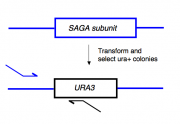Difference between revisions of "20.109(S07): Colony PCR"
| Line 2: | Line 2: | ||
==Introduction== | ==Introduction== | ||
| + | Based on the numerous applications of PCR, it may seem that the technique has been around forever. In fact it is only 20 years old. In 1984, Kary Mullis described this technique for amplifying DNA of known or unknown sequence, realizing immediately the significance of his insight. | ||
| + | |||
| + | [[Image:Be109karymullis.jpg|thumb|left|150px|'''Kary Mullis''']] | ||
| + | |||
| + | ''"Dear Thor!," I exclaimed. I had solved the most annoying problems in DNA chemistry in a single lightening bolt. Abundance and distinction. With two oligonucleotides, DNA polymerase, and the four nucleosidetriphosphates I could make as much of a DNA sequence as I wanted and I could make it on a fragment of a specific size that I could distinguish easily. Somehow, I thought, it had to be an illusion. Otherwise it would change DNA chemistry forever. Otherwise it would make me famous. It was too easy. Someone else would have done it and I would surely have heard of it. We would be doing it all the time. What was I failing to see? "Jennifer, wake up. I've thought of something incredible." '' --Kary Mullis from his Nobel lecture; December 8, 1983 | ||
| + | |||
| + | To begin today’s experiment, you will “pop” some ura+ yeast from your transformation plates and then amplify the relevant portion of the released genomic DNA. The primers you will use are expected to give an ~800 base pair product only if <i> URA3 </i> is inserted into the gene you have tried to delete. [[Image:Macintosh HD-Users-nkuldell-Desktop-colonyPCRprimers.png|thumb|right| PCR primers to check candidates]] This is accomplished by using a forward primer that anneals upstream of the gene you're deleting and a reverse primer that anneals to a region within the URA3 gene. If the <i>URA3</i> gene has inserted elsewhere in the genome (giving rise to the ura+ phenotype) but the SAGA-subunit remains in place, then you will see no product from this reaction. Note, however, that a negative result from these reactions (i.e. no PCR product) can just as easily be explained as a failed PCR (bad primers, dead enzyme, wrong reaction conditions, etc), and might incorrectly lead you to toss out perfectly correct samples. Only the positive result is meaningful in this experiment and we will not know the result until we run the gel next lab. | ||
| + | We will remain optimistic and set up overnight cultures of all the candidates you are examining today. In this way you will have cells to examine next time, when you will screen them for phenotypes arising from loss of the SAGA subunit and when you will isolate total RNA from them for microarray analysis. | ||
| + | |||
==Protocols== | ==Protocols== | ||
===Part 1: Colony PCR=== | ===Part 1: Colony PCR=== | ||
| + | #Begin by counting the colonies that arose from the transformation experiment you performed last time. Choose three candidates (when possible) to pursue, circling the colonies on the back of the petri dish and clearly labeling them "A," "B," and "C." If you do not have enough candidate, don't despair. You can get some additional ones from another group or from the teaching faculty. Note, however, that you may be switching SAGA-subunits and will have to think the work you have planned so far. And in your report it will be worth noting the "negative" result from your work so far, since it may indicate that despite the subunit being deemed non-essential, cells may fair less well than wild-type cells. | ||
| + | #You will use the microwave to release the DNA from the yeast. On the tip of a sterile toothpick, pick-up a dab of a colony from your Petri dish and swirl it in 20 μl of sterile water in an eppendorf tube. Be sure to label the tube so you know it belongs to your group and which candidate it contains. Repeat with the second and third candidates. | ||
| + | #Close the caps and microwave the tubes in an eppendorf rack for 15 seconds. | ||
| + | #Move 5 μl of the microwaved mixes, yeast debris and all, into a 200 μl PCR tube. Again label your tube well (write small!). | ||
| + | #Prepare a PCR cocktail | ||
| + | #Add 45 μl of PCR cocktail to each PCR tube and leave the tubes on ice until everyone is ready. | ||
| + | #Cycle the reactions as: | ||
| + | ##95° 4 minutes | ||
| + | ##95° 1 minute | ||
| + | ##52° 1 minute | ||
| + | ##72° 2 minute | ||
| + | ##repeat steps 2-4 35 times | ||
| + | ##72° 10 minutes | ||
| + | ##4° forever | ||
| + | |||
| + | While these reactions are cycling, you and your partner should work | ||
===Part 2: Set up overnights=== | ===Part 2: Set up overnights=== | ||
| + | #Using sterile technique, aliquot | ||
===Part 3: Journal article discussion=== | ===Part 3: Journal article discussion=== | ||
| + | As part of your assignment for today, you have read the article by [http://www.ncbi.nlm.nih.gov/entrez/query.fcgi?db=pubmed&cmd=Retrieve&dopt=AbstractPlus&list_uids=17000768&query_hl=1&itool=pubmed_DocSum Jimeno-Gonzalez et al, in Mol Cell Biol 2006]. In this article the authors study a different chromatin remodeling complex, FACT. They deplete one of its subunits, namely Spt16, and look at changes in gene expression. Hopefully you can see the relevance of this study to the one we are conducting. | ||
| + | #*Here are some questions to help you think about this article: | ||
| + | #**<b> from the introduction</b> | ||
| + | #**<b> from the results</b> | ||
| + | #**<b> from the discussion</b> | ||
| + | Please come to class next time prepared to discuss the article. | ||
DONE! | DONE! | ||
==For next time== | ==For next time== | ||
| + | #Prepare a table with your transformation results. | ||
==Reagents list== | ==Reagents list== | ||
Revision as of 21:37, 4 January 2007
Contents
Introduction
Based on the numerous applications of PCR, it may seem that the technique has been around forever. In fact it is only 20 years old. In 1984, Kary Mullis described this technique for amplifying DNA of known or unknown sequence, realizing immediately the significance of his insight.
"Dear Thor!," I exclaimed. I had solved the most annoying problems in DNA chemistry in a single lightening bolt. Abundance and distinction. With two oligonucleotides, DNA polymerase, and the four nucleosidetriphosphates I could make as much of a DNA sequence as I wanted and I could make it on a fragment of a specific size that I could distinguish easily. Somehow, I thought, it had to be an illusion. Otherwise it would change DNA chemistry forever. Otherwise it would make me famous. It was too easy. Someone else would have done it and I would surely have heard of it. We would be doing it all the time. What was I failing to see? "Jennifer, wake up. I've thought of something incredible." --Kary Mullis from his Nobel lecture; December 8, 1983
To begin today’s experiment, you will “pop” some ura+ yeast from your transformation plates and then amplify the relevant portion of the released genomic DNA. The primers you will use are expected to give an ~800 base pair product only if URA3 is inserted into the gene you have tried to delete. This is accomplished by using a forward primer that anneals upstream of the gene you're deleting and a reverse primer that anneals to a region within the URA3 gene. If the URA3 gene has inserted elsewhere in the genome (giving rise to the ura+ phenotype) but the SAGA-subunit remains in place, then you will see no product from this reaction. Note, however, that a negative result from these reactions (i.e. no PCR product) can just as easily be explained as a failed PCR (bad primers, dead enzyme, wrong reaction conditions, etc), and might incorrectly lead you to toss out perfectly correct samples. Only the positive result is meaningful in this experiment and we will not know the result until we run the gel next lab.We will remain optimistic and set up overnight cultures of all the candidates you are examining today. In this way you will have cells to examine next time, when you will screen them for phenotypes arising from loss of the SAGA subunit and when you will isolate total RNA from them for microarray analysis.
Protocols
Part 1: Colony PCR
- Begin by counting the colonies that arose from the transformation experiment you performed last time. Choose three candidates (when possible) to pursue, circling the colonies on the back of the petri dish and clearly labeling them "A," "B," and "C." If you do not have enough candidate, don't despair. You can get some additional ones from another group or from the teaching faculty. Note, however, that you may be switching SAGA-subunits and will have to think the work you have planned so far. And in your report it will be worth noting the "negative" result from your work so far, since it may indicate that despite the subunit being deemed non-essential, cells may fair less well than wild-type cells.
- You will use the microwave to release the DNA from the yeast. On the tip of a sterile toothpick, pick-up a dab of a colony from your Petri dish and swirl it in 20 μl of sterile water in an eppendorf tube. Be sure to label the tube so you know it belongs to your group and which candidate it contains. Repeat with the second and third candidates.
- Close the caps and microwave the tubes in an eppendorf rack for 15 seconds.
- Move 5 μl of the microwaved mixes, yeast debris and all, into a 200 μl PCR tube. Again label your tube well (write small!).
- Prepare a PCR cocktail
- Add 45 μl of PCR cocktail to each PCR tube and leave the tubes on ice until everyone is ready.
- Cycle the reactions as:
- 95° 4 minutes
- 95° 1 minute
- 52° 1 minute
- 72° 2 minute
- repeat steps 2-4 35 times
- 72° 10 minutes
- 4° forever
While these reactions are cycling, you and your partner should work
Part 2: Set up overnights
- Using sterile technique, aliquot
Part 3: Journal article discussion
As part of your assignment for today, you have read the article by Jimeno-Gonzalez et al, in Mol Cell Biol 2006. In this article the authors study a different chromatin remodeling complex, FACT. They deplete one of its subunits, namely Spt16, and look at changes in gene expression. Hopefully you can see the relevance of this study to the one we are conducting.
- Here are some questions to help you think about this article:
- from the introduction
- from the results
- from the discussion
- Here are some questions to help you think about this article:
Please come to class next time prepared to discuss the article. DONE!
For next time
- Prepare a table with your transformation results.


